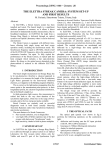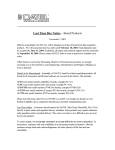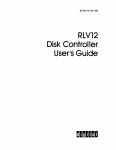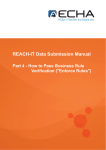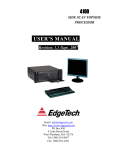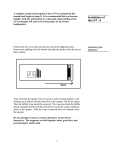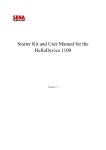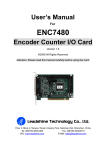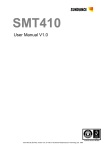Download PC-414COM
Transcript
® PC-414COM ® DSP COMM Port Adapter A/D Interface FEATURES • Adds a powerful A/D “front end” to DSP Array Processor boards • Up to 14MHz transfer rate (7 megasamples/second) without loading host ISA bus • Up to 10MHz A/D sample rates • Mounts directly on DATEL’s PC-414 A/D board • Pin-compatible with TI’s 320C40 COMM ports • Offers full range of A/D options A significant limitation to high-speed analog-to-digital (A/D) converter performance on PC-compatible analog input boards is the slow speed of the host ISA (Industry Standard Architecture) bus. The PC-414COM adapter module avoids these bus delays by sending A/D data directly from a host DATEL PC-414 A/D board to an adjacent third party Digital Signal Processor (DSP) board. The adapter connects to Texas Instruments 320C40 series DSP’s using the “COMM” port digital interface. The COMM port is a fast, byte-wide port with transfer rates up to 7 million samples per second on the PC-414COM. The host PC-414 can collect data to its local FIFO memory at A/D sampling rates up to 10MHz and includes a sample counter for repeated frames of specified size. Or the system can run “forever” with non-stop streaming A/D conversion. For A/D sampling rates above about 7MHz, the PC-414 must briefly stop periodically to allow the DSP to collect data. The adapter is normally offered as an integrated set with its PC-414 A/D carrier board and is ordered together under a common model number. Existing PC-414’s in the field may be modified by DATEL to accept the adapter. Typical applications include all high-speed DSP A/D conversion such as FFT’s (Fast Fourier Transforms), sonar, digital filters, custom test systems, ultrasonics, high-speed control loops, spectrometers, simulators, imaging, and speech processing. The COMM port interface also has a more powerful, subtle speed advantage for the DSP programmer. Instead of having to retrieve the analog data from some slow external bus interface, the A/D data is already “inside the DSP” and can be used immediately or allowed to accumulate in the PC-414 FIFO (First In, First Out) memory for a short time. This non-bus high-speed transfer has a significant advantage for Windows® applications. The PC-414COM is a 3.5-inch by 4.375-inch daughter card which mounts on the host PC-414 A/D board via corner standoffs. The internal system consists of programmable logic configured as a state machine controller. The integrated set of boards occupy one slot width in the host PC. The adapter takes A/D data from the PC-414’s 16-bit parallel data port and reformats it for transmission through the byte-wide COMM port to the DSP. The adapter also connects to the PC-414 parallel digital I/O port for several control signals. These appear as I/O bits on the ISA bus. Please refer to the PC-414 Data Sheet, software diskettes, and User Manuals for full information on this board. Programming Port P2 P4 PC-414 Digital I/O Port P5 RST, HF* +5V Mode Control 40MHz Oscillator Word to Byte Formatter PC-414 Parallel A/D Data Inport DSP COMM Port Header Connector Handshake Logic 16 data XCLK EF* State Machine Controller P3 8 data CSTRB* CRDY* CREQ* CACK* (Alternate Pinout) P1 Figure 1. Functional Block Diagram DATEL, Inc., Mansfield, MA 02048 (USA) • Tel: (508)339-3000, (800)233-2765 Fax: (508)339-6356 • Email: [email protected] • Internet: www.datel.com 105 ® ® PC-414COM SPECIFICATIONS Mounting Method Unidirectional asynchronous digital data interface between a DATEL PC-414 data acquistion board parallel data port and a type “I” (input) 320C40 DSP “COMM” port. The COMM port is the receiver and the PC-414 interface adapter is the transmitter. The purpose is very high speed A/D data transfers which are not slowed down by the ISA bus. The COMM port adapter is a small daughter PC board attached to the PC-414 using existing standoff mounting holes already on the PC-414. The COMM port adapter attaches to both the existing parallel data port and the digital I/O port. One existing connector (P4 on the PC-414 - the older parallel data port) must be removed to fit the PC-414COM adapter. Outline Dimensions 3.5 inches x 4.375 inches Number of Data Bits 8 (one COMM port) Power Required Data Rate 14 Megabytes per second (7 megasamples/sec) typical within a 4-byte burst. +5Vdc power at 500mA max is supplied from the PC-414 digital I/O port (not from the parallel data port). COMM Port Connector Token Assignment The PC-414 COMM port adapter is permanently assigned as a type “O” (output) and will not respond to direction changes. The COMM adapter includes power up “token forcer circuits” per TI’s suggestions. Data Format Data is digitally multiplexed as groups of 4 bytes containing two 12 to 16-bit A/D samples per 32bit longword. The Least Signficant Byte is sent first. One full longword (4 bytes, two A/D samples) is always sent once the first byte is started. See note 1. Dual row right angle flat cable male header, InterCon Systems type 5654-015, 30 pins (2 x 15), mounted beneath the adapter PC board to avoid using more than one PC slot. The COMM port PC board is also pinned out in parallel to an AMP P/N 104069-5 or a Samtech TMS-1-10-01-T-D-RA. When mounted in the host PC, the COMM port connector faces up (i.e., away from the PC’s motherboard). Number of Slots One PC slot (PC-414 plus COMM port adapter). Flat Cable Length The COMM port interface assumes a receiving 320C40 board in an adjacent host PC slot. The flat cable length for maximum speed is 6 inches or less. Greater length may degrade the speed and/or fail to function. Data Overflow Standard status register and/or ISA bus interrupt signals are available on the PC-414 carrier board to indicate FIFO overflow (lost data). PC-414 FIFO Size 4096 samples (Typical at +25°C under dynamic conditions unless noted) Function Data Flow Control Uses standard 320C40 CSTRB*/ CRDY* handshake protocol as specified in the Texas Instruments documentation. The byte transfers use the following mode: The CSTRB* output will remain inhibited until the PC-414 A/D FIFO memory is half full or greater. At FIFO half full, the COMM port interface will send four bytes (two A/D samples) to the DSP receiver using normal CSTRB*/CRDY* handshaking then will inhibit CSTRB* until FIFO half full occurs again. If the FIFO is continuously half full or greater, the interface will send data as long as the DSP accepts it. See Note 2. Logic Controls The COMM port will inhibit data transfers when the PC-414 A/D data FIFO is empty. State Machine Reset This is controlled from an output bit on the PC-414 digital I/O port or from P1-29. See Note 3. Notes 1. Both CREQ* and CACK* have internal terminations as shown and are used by the token forcer circuits. The PC-414COM adapter is always the token owner. 2. In operation, the A/D FIFO will always store the last half FIFO’s worth of data. The DSP can always get as much data as it needs as long as the A/D continues sampling. If A/D sampling stops, the last half FIFO may be read from the ISA bus. In addition, the DSP can ignore the COMM port interface by not responding with CRDY* even if the A/D continues running. 3. A CAUXRES* input is not provided to the PC-414 COMM port interface. This control normally resets the PC-414 and the COMM port interface. However these functions are available from the ISA bus register controls. DATEL, Inc., Mansfield, MA 02048 (USA) • Tel: (508)339-3000, (800)233-2765 Fax: (508)339-6356 • Email: [email protected] • Internet: www.datel.com 106 ® ® PC-414COM Applications Data Format and Channel Synchronization Since the PC-414COM adapter is downstream from the PC-414’s FIFO on-board memory, the system can collect data non-stop continuously to the DSP at high speed with no lost samples. The architecture differs significantly from competitive designs. Also the full range of triggering, sample clocking, and channel addressing is available from the host PC-414. These functions are controlled from the ISA bus and are normally set up only once at the beginning of the A/D session. Data is delivered to the COMM port in whatever format was selected on the PC-414. Each A/D sample is right justified and may be sign-extended on the PC-414. For multi-channel data, the channel ordering is multiplexed with a typical 4-channel data stream having the channel sequence: 0, 1, 2, 3, 0, 1, . . . indefinitely. Therefore data must be demultiplexed (“unraveled”) on the DSP side. For highest speed, there is no channel address tagging to add overhead to the data stream, so DSP software must not get out of sequence. The DSP array processor board is typically placed in an adjacent or nearby ISA slot with a short flat cable and connector assembly. Refer to the specifications for details. Some applications assign an unused analog channel to a known DC voltage for positive channel synchronization. Also, the PC-414 can use counted frames with an ISA I/O port status indication and optional interrupt when a frame is complete. Channel addressing always starts on channel zero for the beginning of a frame therefore a reliable counting algorithm will fully recover all channels. Since the trigger frame timing, sample counter and FIFO flags on the PC-414 are all independent, users should either fully empty the FIFO after each frame (using the empty bit to verify) or reset the FIFO or make absolutely sure your counting function does not lose channel synchronization. Other applications may detect excessive intersample differences to flag discontinuities as an indication of lost samples. Formatting and Handshaking The PC-414COM adapter accepts two 12, 14, or 16-bit A/D words and reformats them as four bytes to be sent across the COMM port interface. The on-board logic handshakes with the COMM port protocol and will automatically attempt to send bytes if the adapter is ready. As long as the DSP responds to CSTRB* outputs from the adapter with CRDY* handshakes, data will be sent to the COMM port. Since the DSP completely controls this handshaking, the DSP can accept data at the rate and amount that it needs. Any data which is not immediately used will accumulate in the PC-414 FIFO and will not be lost as long as it is read before the FIFO overflows. The DSP can read a longword at a time or initiate a burst. Two A/D words are always formatted as four bytes for compatibility with the 32-bit longword architecture of the COMM port. The PC-414COM port is permanently assigned as a type “O” (output) COMM port and will ignore change of direction or token passing requests. The receiver DSP board must be a type “I” input. The PC-414COM includes a token forcer circuit to initialize the C40 to an “I” input. Start ➀ Collect A/D data to FIFO Yes A FIFO overflow condition sets an ISA bus maskable interrupt or status flag. Full ISA bus controls can inhibit the A/D at any time, reset the FIFO and start again. In addition, the OUT0 parallel port bit (P5-20) will clear the state machine controller when low. The DSP receiver can program the COMM port in DMA or program transfer mode. DSP needs more data? FIFO >half full? No No Exit The Last Block of Samples Yes Since the controller inhibits transfers below FIFO half full, the very last group of samples, after the A/D has permanently stopped, may be read from the FIFO using the ISA bus (after switching PC-414 Command Register bit 6 to ZERO). Assert CSTRB* The PC-414COM works well with signal streaming where the A/D either runs continuously or at regular on/off periods in counted blocks. These applications usually have a bandwidth problem and therefore need a high speed COMM port interface. No CRDY* asserted? For lower speed applications or ones with very short A/D sequences, these will not activate the COMM port interface until the A/D FIFO is at least half full (2049 samples). Thus there will be an initial delay at first before data reaches the DSP. And samples will be left in the FIFO at the end of the session. The beginning delay is primarily a data skewing issue, taken care of by properly indexing the data. The data which is still in the FIFO after A/D sampling stops must be removed by ISA bus access. Or leave the A/D running long enough to deliver all needed data then discard the last half FIFO. Repeat four times (one longword) Yes Transfer 1 byte. Deassert CSTRB* Note ➀ - A/D sampling continues non-stop during COMM port transfers Figure 2. PC-414COM Flow Diagram DATEL, Inc., Mansfield, MA 02048 (USA) • Tel: (508)339-3000, (800)233-2765 Fax: (508)339-6356 • Email: [email protected] • Internet: www.datel.com 107 ® ® PC-414COM PROGRAMMING P1 CONNECTOR Normally, software provided by the Array Processor board supplier will completely control the COMM port from the DSP side. Free low level software libraries are available from DATEL to control the PC-414 or the PC-414SET program can be used. The overall sequence of operation is to set up the host interrupt systems, initialize the PC-414, prepare the DSP to accept COMM port transfers then start A/D conversion on the PC-414. The DSP may then retrieve A/D data indefinitely without further programming the PC-414. To set up the PC-414, program all registers normally except that the Command Register bit 6 must be set to ONE to enable the parallel data port connection to the COMM port adapter. Note that A/D data may be steered to either the ISA bus or the parallel/COMM port but not both simultaneously. These selections are mutually exclusive. Use two I/O writes with bit encoding to reset then run the controller. Use this two-write sequence anytime that the controller appears to be locked up, indicated by a loss of control. After everything is initialized, enable A/D sampling in the PC-414 Command Register. After power up and any time the adapter controller is reset, CSTRB* will not be asserted if the A/D clock is not running yet and the trigger has not started gating A/D samples into the FIFO. Host system code should be running concurrently with the DSP so that overflow (lost data) interrupts are processed from the PC-414. In cases where the DSP is also the ISA bus master, the DSP should periodically test for overflow status. Please note that when the COMM port adapter is installed, the FIFO must be 4096 samples. This pad area accepts two 2-row 30 pin connectors (15 pins per row) with different spacing between rows. There are three rows total with equal spacing between the rows. The connector types are either the Intercon Systems or AMP (see specifications). Pin 1, 31 - Data 0 Out Pin 2 - Grounded via SG1 Pin 3, 32 - Data 1 Out Pin 4 - Ground Pin 5, 33 - Data 2 Out Pin 6 - Ground Pin 7, 34 - Data 3 Out Pin 8 - Ground Pin 9, 35 - Data 4 Out Pin 10 - Ground Pin 11, 36 - Data 5 Out Pin 12 - Ground Pin 13, 37 - Data 6 Out Pin 14 - Ground Pin 15, 38 - Data 7 Out Pin 16 - Ground Pin 17, 39 - CSTRB* Out Pin 18 - Ground Pin 19, 40 - CRDY* In Pin 20 - Ground Pin 21, 41 - CREQ* Pin 22 - Ground Pin 23, 42 - CACK* Pins 24, 26, 28, 30 - Ground Pins 25, 27, 43, 44 - No connection Pin 29, 45 - CTOKRES* input with 10Kohm pullup to +5V. If J1 1-3 is closed, a LOW on this input resets the controller. If J1 13 is open, only the pullup remains. Note that controller reset is fully controllable from the ISA bus if J1 1-2 is closed. VERY IMPORTANT The two inner rows of this 3-row connector (the two rows away from the board edge) are connected in parallel. P4 CONNECTOR This pad area accepts a 2-row 20 pin connector. The connector type is a Samtech TMS-1-10-01-T-D-RA (see specifications). Pin 1 - Ground Pin 2 - Data 0 Out Pin 3 - Ground Pin 4 - Data 1 Out Pin 5 - Ground Pin 6 - Data 2 Out Pin 7 - Ground Pin 8 - Data 3 Out Pin 9 - Ground Pin 10 - Data 4 Out Pin 11 - Ground Pin 12 - Data 5 Out Pin 13 - Ground Pin 14 - Data 7 Out Pin 15 - CREQ* Pin 16 - Data 6 Out Pin 17 - Ground Pin 18 - CACK* Pin 19 - CRDY* In Pin 20 - CSTRB* MISCELLANEOUS I/O BITS and JUMPERS PC-414 Parallel port outbit 0 (I/O word BASE+2, bit 8): 0 = Reset internal state machine controller if J1 1-2 is closed 1 = Run Jumper J1 (use only one setting): 1-2 Reset state machine from I/O outbit 0 (see above) 1-3 Reset state machine from a LOW on P1-29 Connector P2: For programming the internal state machine controller. Make no connection. Solder gap SG1: Closing this gap grounds P1-2 and P1-4. PAL changes: The host PC-414 requires a change of its Programmable Array Logic to provide FIFO empty and half full signals on the P3 connector. Also, faster 0.3-inch DIP FIFO’s are required. CONNECTOR PINOUTS The PC-414COM adapter is offered in 3 different COMM port connector pinouts. Only one connector is installed. All pinouts are shown component-side view. Silkscreening on the board locates pin 1 which is also indicated with a square circuit pad. DATEL, Inc., Mansfield, MA 02048 (USA) • Tel: (508)339-3000, (800)233-2765 Fax: (508)339-6356 • Email: [email protected] • Internet: www.datel.com 108 ® ® PC-414COM Flat Cable DSP Array Processor Board (adjacent slot) DSP COMM Port Connector (between boards) (user supplied) A/D Parallel Data Port P1/P4 P3 2 1 3 J1 1 Access Hole for DIP Switches Analog Inputs A/D Module FIFO A/D Memory Controller Parallel I/O Port P5 PC-414 A/D Board PC-414 COM Adapter Analog Inputs PC-414COM Adapter P1/P4 A/D Module P3 Mounting Standoffs DSP COMM Port Connector PC-414 Carrier Board (edge view, top chassis) Figure 3. Configuration Diagram Digital Outport on PC-414 (I/O Base + 2) 15 Connector P5 8 0 RST* 2 1 3 Controller 1 31 +5V J1 2 SG1 4 10kΩ CSTRB* OUT CRDY* IN CREQ* CACK* CTOKRES* (Reset*) 17 19 21 23 29 39 40 41 42 45 30 P1 COMM Port To P4 Figure 4. I/O Terminations and Jumpering DATEL, Inc., Mansfield, MA 02048 (USA) • Tel: (508)339-3000, (800)233-2765 Fax: (508)339-6356 • Email: [email protected] • Internet: www.datel.com 109 ® ® CRDY* (to PC-414COM) (from PC-414COM) CSTRB* DATA Timing is not to scale FIFO has 2049 samples CRDY* IN CSTRB* OUT COMM Port Data ACQuire <Half Full >Half Full FIFO Empty Not Empty Trigger A/D Clock Sampling All registers starts. Begin armed frame. ➀ ➁ See detail ➂ See detail (from PC-414COM) Transfer 4 bytes See detail Byte 0 Byte 1 72ns typ. Sample Next frame count reached. start Stop A/D ➃ PC-414COM Figure 5. System Timing Diagram Notes 1. Trigger width must be less than the frame length. 4. ACQuire remains high indefinitely and no further trigger is needed if the sample counter is disabled in non-stop, continuous streaming mode. 2. Timing is shown with a non-stop A/D clock. 3. At high A/D speeds, half full rapidly toggles or will remain true if the DSP lags behind. DATEL, Inc., Mansfield, MA 02048 (USA) • Tel: (508)339-3000, (800)233-2765 Fax: (508)339-6356 • Email: [email protected] • Internet: www.datel.com 110 ® ® PC-414COM PC-414COM Setup Instructions 8. Set up the DSP board to accept data from the PC-414. If necessary, verify that the COMM port on the DSP side is truly empty and inactive. Set up the PC’s interrupt system to accept PC-414 interrupts, if used. Allocate PC memory and open files as required. CAUTION: Incorrect DSP DMA programming can lock up the DSP. Test the DSP COMM port in status mode first. 1. Solder Gaps Before installing the PC-414 board, verify that the solder gaps are properly set on the non-component side of the board. Using anti-static protection, hold the board with the components facing away from you and the ISA bus connector at the lower left. Solder gaps SG1 and SG2 are next to each other in the top center of the board directly under a standoff mounting hole. SG3 is at the top right, directly below the P3 connector. 9. If external triggering is desired, the PC-414 A/D Command Register requires two writes. The first write sets external triggering (bit 0=1) leaving the A/D temporarily still disabled (bit 1=0) The second write to the Command Register sets bit 0=1 (again) and bit 1=1 to start the A/D. To avoid a mode lockup, do not toggle both bits 0 and 1 with the same write. Set the solder gaps as follows if not already done. Get experienced assistance if you do not have excellent soldering skills: SG1 = Open. SG2 = Closed. For internal triggering, only one write to the Command Register is needed. For either internal or external triggering, carefully set all bits correctly. Set bit 6=1 to enable the parallel data port on the last Command Register write. This connects P3-17 to the “XFLAG” output on U5. XFLAG is selected for the FIFO Empty Flag by special programming of the PC-414COM PAL’s. A standard PC-414 does not have this PAL programming. Note that this is triggering, not A/D sample clocking. The system should now be sending data to the DSP board unless it is waiting for an external trigger. Optionally verify progress by testing the ACQuire and FIFO empty flags in the Status Register. CAUTION - Do not close both SG1 and SG2 simultaneously. SG3 = Closed. This connects the “XCLK” external handshake clocking from the COMM port. You may vary the above sequence as long as the A/D Command Register is last (starts A/D conversion). DATEL strongly recommends testing the PC-414 with data sent to the ISA bus (bit 6=0) first to verify that everything else works. Carefully examine the output data array from the FIFO. If your code is not working, try DATEL’s PC-414SET diagnostic. 2. Set PC-414 SW2 DIP switches 4 and 5 both off. This selects parallel port transfer mode 3 (external clocking). See Figures 6.4 and 6.5 in the PC-414 User Manual. These switches appear in a cutout in the middle of the COMM port adapter. 10. When all data is taken, stop the A/D and reset the adapter. 3. COMM port Adapter settings: Set Jumper J1 on the COMM port adapter to connect J1 1-2 (reset via I/O bit 8). Close P1SG1 on the adapter if desired for your required grounding. See the P1 pinout in the PC-414COM data sheet. For debugging purposes only, the former Busy Low output on P3-11 is reassigned as FIFO Half Full* output for use with the COMM port. This change is done by special PAL reprogramming which is not available on a standard PC-414. 4. Review all other PC-414 switches and jumpers very carefully according to the PC-414 User Manual then install the board. Connect the COMM port cable to the DSP receiver board. CAUTION: The adapter actively drives the outputs and the receiver must be set up as a type “I” (input) device. The adapter does not run in 3-state mode. If you are debugging your own code, consider partly repeating the programming above each time new data is taken for diagnostics so that the system always starts in a known state. Some final advice: In order to successfully pass data into the A/D FIFO, five conditions must be met. Valid input signals must reach all the way to the input terminals on the A/D converter itself, the FIFO must not be full, the A/D sample clock must be running, a trigger must have occurred and the A/D must be enabled in the Command Register. In order for correct data to be accumulated, many other conditions must be met including sampling at Nyquist rates or better, not exceeding the input range, preventing alias signals, remaining within the input common mode range, reducing input noise, etc. Programming Sequence Properly programming the COMM port system requires correct instruction sequences for four sections (the PC-414, the receiving DSP board, the COMM port adapter and the host PC). The philosophy here is to get the downstream items prepared to accept data before the upstream devices. 5. Write a 0000h to the PC-414 Command Register to disable the A/D section and parallel data port. This should occur by default at power up. Program the PC-414 timers and all other registers except the Command Register. Reset the A/D FIFO. In order to successfully pass data through the COMM port to the DSP, the adapter controller must be in the “run” state, the DSP must be properly programmed, the A/D FIFO must be steered to the parallel port and the data cabling must be perfect. 6. Reset the COMM port adapter by writing the PC-414 Digital I/O Outport (I/O Base+2) with bit 8=0. Allow a small delay after this write for the reset state to propagate through the controller. Note that the I/O port should power up with bit 8=0 so you may be able to skip this step if your testing shows high reliability. 7. Write the I/O Outport again with bit 8=1 (run). DATEL, Inc., Mansfield, MA 02048 (USA) • Tel: (508)339-3000, (800)233-2765 Fax: (508)339-6356 • Email: [email protected] • Internet: www.datel.com 111 ® ® PC-414COM ORDERING INFORMATION (Adapter board only - requires modifications on PC-414 carrier board): PC-414COM1 PC-414COM2 PC-414COM3 Intercon header connector (for Ariel) AMP header connector (for Radisys Sonitech) Samtech TMS-1-10-01-T-D-RA header Please order only using the full board model numbering: PC-414x2COMy where “x” indicates the selected A/D option for the PC-414 A/D board, and “y” indicates the COMM port connector as indicated above. Example: PC-414F2COM2 Please refer to the PC-414 data sheet. Note that model numbering is structured per order. PC-414 ORDERING INFORMATION MODEL NUMBERING PC-414 2 A/D Type, Channels, Resolution A = 4 SSH chans., 12-bit B = 4 chans., 14-bit C = 4 chans., 12-bit D = 1D chan., 12-bit E = 16S/8D chans., 12-bit F = 2 simul. chans., 12-bit G = 2 simul. chans., 14-bit H = 1D chan., 12-bit J = 8 simul. chans., 12-bit L = 16 simul. chans., 12-bit M = 4 simul. chans., 16-bit COM2 FIFO Memory Size 2 = 4,096 A/D samples Use the 4k FIFO only for the COMMport. Input Polarity A = Bipolar B = Unipolar Use this designator only for G models requiring polarity section. COMM Port Add for COMM port interface Example: PC-414F2COM2 Two simultaneous A/D’s, 2MHz, 12-bit resolution, 4,096 FIFO samples. 61-7342340 PC-490B SMA male to BNC male coaxial cable, 1 meter length. (One cable required per channel) DB-25 screw termination adapter, 25-pin for PC-414E, J, L. Each board is power-cycle burned-in, tested, and calibrated. All models include a user manual. The warranty period is one year. A QuickBASIC and low-level “C” library source disk is available on request at no charge. For complete information see PC-414 data sheet. Note: Software is not included with board. Please add to your order. Windows is a Microsoft trademark DATEL, Inc., Mansfield, MA 02048 (USA) • Tel: (508)339-3000, (800)233-2765 Fax: (508)339-6356 • Email: [email protected] • Internet: www.datel.com 112








